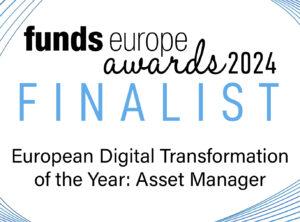
#34 - Behind The Cloud: AI in Risk Management - Navigating Uncertainty in Asset Management (1/9)
The Foundation of Risk Management – AI’s Role in a Complex Landscape
January 2025
AI in Risk Management: Navigating Uncertainty in Asset Management
This new series redefines the role of AI in risk management, bridging academic advancements and practical applications in asset management. With a focus on transparency, explainability, and innovation, it will educate both AI enthusiasts and non-specialists about the transformative potential of AI-driven risk strategies.
The Foundation of Risk Management – AI’s Role in a Complex Landscape
Risk management is the cornerstone of asset management, where decisions hinge on navigating uncertainty to protect investments and deliver returns. But the financial landscape is evolving, with global markets more interconnected and complex than ever before. Traditional methods of managing risk—built on static models and human intuition—are increasingly struggling to keep pace with today’s dynamic challenges.
This is where Artificial Intelligence (AI) steps in. By leveraging its capacity to process vast datasets, detect patterns, and make predictions, AI is transforming risk management into a proactive, precise, and adaptable discipline.

As we embark on this new series, “AI in Risk Management: Navigating Uncertainty in Asset Management”, we’ll explore how AI is reshaping the way risks are identified, assessed, and integrated into investment strategies.
The Critical Role of Risk Management in Asset Management
At its core, risk management seeks to strike a balance: protecting investments from downside risks while identifying opportunities to generate returns. In asset management, risks take on many forms:
- Market Risks: Volatility in equity, bond, or commodity markets driven by economic shifts or geopolitical events.
- Liquidity Risks: The inability to buy or sell assets without significantly affecting their prices.
- Credit Risks: The potential for counterparty defaults or credit quality downgrades.
- Operational Risks: Cybersecurity breaches, regulatory non-compliance, and technology failures.
- Systemic Risks: Broad, cascading impacts like global financial crises or major geopolitical shocks.
For decades, managing these risks has relied on historical data analysis, scenario modeling, and human judgment. While these methods have served the industry well, they often struggle with dynamic, fast-moving risks in real time. This is where AI brings game-changing potential.
Why AI is Revolutionizing Risk Management
AI redefines risk management by turning static processes into dynamic, predictive systems. Instead of reacting to risks after they occur, AI can analyze patterns, flag emerging threats, and guide asset managers in real time.
Key Advantages of AI in Risk Management:
- Early Detection of Emerging Risks: AI can process structured data (e.g., market trends) and unstructured data (e.g., news sentiment, social media activity) to identify risks before they materialize.
- Predictive Insights: Through machine learning models, AI enables scenario-based forecasting, helping asset managers prepare for market disruptions.
- Automation and Efficiency: Routine tasks, like monitoring market movements or regulatory changes, can be automated, freeing up human talent for strategic decision-making.
- Dynamic Adaptation: Unlike traditional models, AI systems continuously learn and adapt, ensuring relevance in ever-changing market conditions.
For asset management firms, this means better resilience, stronger decision-making, and enhanced client confidence.
The Evolving Nature of Risk
Risk is no longer just about defense—it’s also about opportunity. Understanding and quantifying risk can uncover opportunities for growth and outperformance.
For instance:
- In volatile markets, risk-aware AI systems can identify undervalued assets or sectors poised for recovery.
- In regulatory environments, AI-driven compliance tools ensure strategies are both efficient and aligned with global standards.
- In operational contexts, AI can mitigate threats like cybersecurity breaches, ensuring smooth and secure operations.
By turning risk into an informed lens for decision-making, AI not only protects portfolios but enhances their potential for sustainable performance.
Framing the Series: What to Expect
Over the next eight weeks, we will delve into how AI transforms every stage of the risk management process, from identification to integration into investment strategies.
Upcoming Topics Include:
- AI in Risk Identification – How AI systems detect emerging threats before they impact portfolios.
- Quantifying Market Uncertainty – AI-driven risk models that bring precision to volatile markets.
- Predicting Black Swans – Preparing for the unpredictable with advanced AI capabilities.
- Scenario Analysis with AI – Using stress tests to navigate turbulent markets.
- Mitigating Operational Risks – How AI strengthens cybersecurity and compliance frameworks.
- Integrating Risk into Investment Strategies – Aligning AI-powered risk assessments with portfolio management.
- The Role of Explainability in Risk Assessment – Building trust in AI-driven systems by clarifying how they work.
- The Future of Risk Management – Exploring what’s next for AI innovation in navigating uncertainty.
Omphalos Fund: Leading the Way in AI-Driven Risk Management
At Omphalos Fund, we’ve always recognized that the foundation of effective investing lies in robust risk management. By integrating AI into our processes, we’re transforming how we assess, mitigate, and leverage risks.
Our Commitment Includes:
- Proactive Risk Monitoring: Using advanced AI tools to identify threats in real time.
- Predictive Analytics: Forecasting risks across asset classes with unparalleled accuracy.
- Transparent Processes: Ensuring that our AI systems are explainable, building trust with clients and stakeholders.
This hybrid approach of cutting-edge AI and human oversight empowers us to deliver resilient and high-performing investment strategies.
Conclusion: Building Smarter Risk Management Systems with AI
The intersection of AI and risk management is not just a technological advancement—it’s a strategic imperative for asset managers navigating today’s complex landscape. By harnessing AI’s capabilities, firms can move from reactive risk management to predictive and proactive approaches.
This concludes our first chapter in the series “AI in Risk Management: Navigating Uncertainty in Asset Management”. In the coming weeks we will uncover how these technologies are shaping the future of the industry, offering insights into their transformative potential.
Join us next week in Behind the Cloud, for our first deep dive: “AI in Risk Identification – Spotting Early Warning Signs,” where we’ll explore how AI systems detect risks that traditional methods often overlook.
Stay tuned!
If you missed our former editions of “Behind The Cloud”, please check out our BLOG.
© The Omphalos AI Research Team – January 2025
If you would like to use our content please contact press@omphalosfund.com



